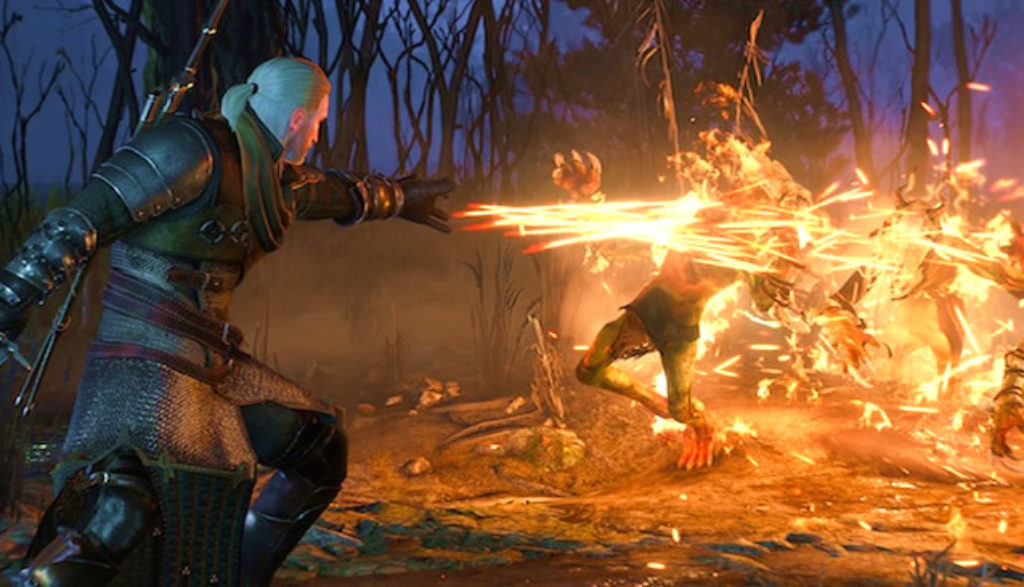
When I encounter a huge role-playing game, I can’t help but think, “How long must it have taken to create something like this?” That’s especially true in the case of The Witcher III: Wild Hunt. This overwhelmingly massive open-world actioner delivers a dense and deep environment with an almost hand-drawn feel. It’s a place of stormy black forests, phantom-choked battlefields and verdant, rolling fields—a world dotted by ramshackle villages, ancient ruins, steaming bogs, rutted grassy pathways and rocky hillsides.
And that’s just the landscape.
Because when you add up all the digital miles of countryside to traverse, the hundreds of characters to interact with, and all the main and side quests and battles to undertake, you end up with a game that is a claimed “30 times larger” than any other Witcher entry and some 20% bigger than a game like Elder Scrolls V: Skyrim.
A Witcher Fights for His Ward …
To take on this 100-plus-hour journey, players slip into the shoes, scar-covered skin and ongoing story of a “witcher” by the name of Geralt. He’s a paid monster-slayer who’s been physically enhanced through sorcery and mutation. And after fully recovering his memory at the end of Witcher 2, Geralt is now on the personal mission of seeking out a young woman named Ciri, the closest thing he has to kin.
Geralt once trained this high-blood imbued girl in the witcher ways as his ward, but the now twentysomething warrior is currently at large, somewhere out in the Northern Kingdoms (a place reminiscent of Westeros from Game of Thrones, but with an even darker and more demonic malevolence at its core).
The black evil forces of the Wild Hunt have invaded the land, and for some mysterious reason, they believe Ciri to be a key to their plans for blood-soaked world domination. Geralt must follow Ciri’s trail—seeking out clues in exchange for fulfilling scores and scores of quests handed down by nobles, journeymen, magickers and even beggars—in a desperate effort to find and help her. And, of course, that also means he’ll be killing werewolves, ghouls, trolls, hideous demons, deformed witches and everything else that growls and leaps in his direction.
… Without Any Need of Right or Wrong
Gameplay wise, Witcher III is pretty similar to past entries. There’s a deep crafting system for weapons, armor, potions and the like. There are lots of opportunities for finding treasure, scavenging materials and digging up physical clues. Geralt can master magical Jedi-like abilities to get others to obey his wishes and commands. And each conversation he has opens up the possibility of various dialogue directions and actions. Geralt can talk himself out of a sticky situation with a gang of thugs at a local tavern, for example, or throw niceties to the wind and wade in with sword drawn.
There’s a troubling aspect to that interactive element here, though, because the choices made don’t determine Geralt’s goodness or villainy. Like past games in the series, each action taken is viewed through an utterly amoral lens. The choices can certainly shape which of a number of paths Geralt will take—sometimes fundamentally changing the world at large and how the end story might play out—but they don’t reinforce or even acknowledge the larger question of what constitutes good or evil in an individual’s actions. Geralt, therefore, can be just as murderous as his foes and still be something of a hero.
That sense of ethics-free duality even plays out in statements the game tries to make. Early on in the tale when Geralt encounters a scholarly chronicler of war in a tavern, for instance, the witcher makes a point of saying that war should be seen as the horrible thing it is, “not colorful banners or generals making moving speeches, but rape, violence and thoughtless cruelty.” And yet so many of Geralt’s own possible actions fly right in the face of his supposed antiwar sentiments—offering gamers the exploitive possibility of unleashing a rampant slew of carnality, death and cruelty.
The Resulting Sleaze and Slaughter
Geralt voices his undying love for a beautiful enchantress named Vennefer, but he can readily seduce and bed a number of female partners, including an elven prostitute in a brothel. The camera ogles the mostly naked bodies of the witcher and his bedmates (exposed legs, torsos, breasts and buttocks) with close-up shots and long panning gazes, and sticks around for moans and moments of near orgasmic virtual reality as the couples intertwine.
Characters often drink heavily throughout (and also in a quest-based drinking game), swear readily (f-, s- and c-words) and play around with dark spiritual rituals (spells and incantations involving blood and severed body parts). One particularly nocuous magicking turns a miscarried fetus into a slavering umbilical-cord-wrapped demon creature.
Then there’s the death-dealing. This game displays all manner of extremely gory and fierce ways to rip, slash and tear both man and beast. Hacking and slashing soldiers leave a battlefield scattered with dead bodies, horses and other animals have their heads lopped off and entrails torn out, people are ripped limb from limb before their goopy remains are examined for CSI-like clues, great mythical beasties gorge themselves on the torn flesh of others, and a bird flies in and through someone’s eye socket. Quite often, particularly bloody violence is fetishized with slow-motion shots showcasing every nuance of a brutal decapitation or dismemberment.
None of this debauchery and butchery is necessarily new when it comes to Witcher games. But when the world this franchise boasts becomes so intricately detailed and the horror goes on for more than 100 hours, well, it’s certainly worth repeating as a warning. A dire warning.

After spending more than two decades touring, directing, writing and producing for Christian theater and radio (most recently for Adventures in Odyssey, which he still contributes to), Bob joined the Plugged In staff to help us focus more heavily on video games. He is also one of our primary movie reviewers.